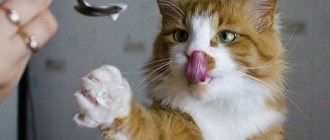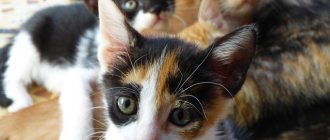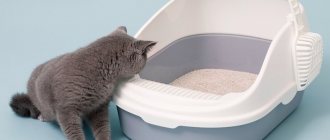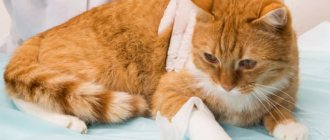Cats bring comfort and love to your home. Once they appear in an apartment, they immediately begin to occupy an important part of the owners’ lives. Without a cat, everything seems to become gray and lonely. At the same time, all the beauty and convenience can disappear if the pet begins to behave unusually for all the inhabitants of the house. The most common problem is that the cat pees everywhere. This is a truly unpleasant phenomenon that can bring a lot of inconvenience. Naturally, it is better to solve such problems immediately. Loving owners are simply obliged to thoroughly understand this.
Why did the cat start shitting?
At some point in a cat's life, problems with uncleanliness can arise in every pet. Finding out the reasons for bad behavior right away is not easy. In addition, the cat is capable of both marking everywhere with urine and feces, and shitting. These are different things and need to be understood.
Below are the most common causes of uncleanliness.
Diseases
There are too many diseases that can change a cat's habits. Therefore, before correcting behavior, internal diseases should be excluded or treated.
If a cat begins to pee in the wrong place, it may not have time to run due to developed cystitis or urethritis. Urolithiasis, pathologies of the kidneys, liver, and diabetes mellitus lead to urinary retention, frequent urges, and pain that the pet experiences when urinating. The cat has an association that when he does his business in the litter box, it will hurt. Therefore, he tries to avoid this.
There are situations when a cat regularly goes to urinate in the tray, but generally in another place. In this case, constipation, gastrointestinal disorders, food allergies, and neurological disorders are excluded. Pain during defecation, which occurs in a pet due to constipation, too dry stool and other pathologies, is also the reason for refusing the usual toilet.
If you suspect problems with the genitourinary system (frequent visits to the toilet, changes in the color and smell of urine, lethargy of the pet), you should contact a veterinarian to find out the disease and begin treatment.
Age-related changes
For a 1-2 month old kitten, it is natural that he forgets that he is running to the toilet or simply does not have time to convey it. Such mistakes need to be forgiven, not to swear, and especially not to hit if the kitten shits in the wrong place. It is believed that kittens begin to consistently do according to the rules from 3-4 months.
In older animals, the sense of smell changes, vision deteriorates, and problems with the musculoskeletal system arise. Therefore, perhaps the sides of the tray are too high and the cat cannot get into it or the smell of the litter has become irritating.
Tray condition
If the cat is healthy, you need to analyze the situation with the bathroom: whether the filler was changed, whether the tray was moved to another place, maybe the cat was scared or the toilet was not cleaned regularly. The cleanliness of cats is based on the instinct of self-preservation. In nature, they bury feces so that the smell does not attract predators and try to go to the toilet away from their shelter. This instinct is preserved in completely domestic pets. Some are so clean that they will not go into the litter box after peeing there once.
Experts give the following advice:
- Shake the filler 2 times a day.
- Complete replacement of clumping filler - at least once a month, absorbent - at least once every 2 weeks.
- After removing the granules, wash the container with a harmless product (soda, a little soap).
Cats are sensitive to the condition of the litter box. They may refuse to go to the toilet if it is dirty, not cleaned or smells bad. Therefore, the product without filler is washed after each visit. Do not use products with a strong odor. It is better to wash with just water or add a drop of liquid soap.
After peeing in the litter box, the cat may decide that it has become dirty so that he can also poop in it. Therefore, it is better if one pet has 2 trays.
Symptoms of pathology
Normally, the mustachioed friend does not experience discomfort when visiting the toilet: urine is released quickly, and the cat does not sit in the litter tray for long. If your furry one begins to linger in the toilet, going there more than 3-4 times, then you need to pay attention to the amount of water he drinks and the color of the urine. The following symptoms may be a cause for concern:
- during urination, the pet meows and experiences obvious discomfort;
- the pet has become lethargic and apathetic;
- urine has an unusual color and a pungent odor, sometimes blood appears in it;
- the number of trips to the toilet increases for no obvious reason;
- Always well-mannered, the cat suddenly begins to shit - this is due to the fact that the litter box causes him to associate with painful sensations;
- The cat often urinates in small portions.
Bright yellow or orange liquid or drinking too much water are not causes for concern - they are usually associated with high temperatures outside the window.
Marks or shits: it’s important to know the differences
Males, females and a certain percentage of castrated cats mark their territory. They usually mark vertical surfaces: walls, door frames, curtains. A mark is not just urine, when a cat raises its tail, wags it and leaves a mark. The animal also leaves a mark with its claws, since between the fingertips there are glands that secrete a secretion. Rubbing the muzzle against objects is also a mark. A cat or cat can regularly go to the designated place, but at the same time leave marks. Therefore, “marks” and “shits” are different concepts.
If your pet begins to mark, castration will help. Ideally, a cat is castrated before puberty. An adult cat that has already begun to mark will continue to do so for some time after surgery.
Methods of influence
In the fight against uncleanliness, there are a number of other ways to stop a cat from shitting in the wrong place:
- Method of imprisonment. When a cat is left alone during the day or at night, limit its space to one room, where there is a tray, bowls with food and water. Thus, as if forcing the use of a pallet. It shouldn't be a room where she gets dirty.
- Supervision. If the owner has time, then it is possible to wean off crap using constant monitoring. The animal goes into another room, the owner follows. The cat sits down to urinate, the owner needs to stop him or distract him. To do this, small nails or peas (buckwheat) are poured into a plastic jar and when the pet settles down to defecate, the jar is thrown into that part of the room, but not into the animal. Cats are afraid of noise, they will try to avoid this place where it is scary.
- Cleaning the place. It is equally important to thoroughly wash the area where the animal gets dirty. You need to choose the right product to treat the area with. There are many commercially available substances that remove urine and odor from feces. Better is one that not only removes the odor, but contains enzymes that decompose urine and excrement. Do not use bleach or any substances containing ammonia. The latter enhances the smell of urine.
- Change the purpose of the place. To prevent the cat from spoiling, the owner needs to limit access to the places that she has chosen for her business and make them unattractive for getting dirty:
- The cat likes the carpet, so you need to turn it over to the other side.
- Place double-sided tape on the floor where it leaves puddles and piles.
- Spray with a liquid with a citrus aroma, it has a repellent effect or store-bought Antigadin.
- To prevent people from crap in the corners, they are blocked off with large-sized furniture and other fences. You can cover the corner with foil or plastic.
- People are weaned off the bathtub and sink by leaving a little water there.
- If a cat shits in a flower pot and it’s definitely not the filler, you can cover it with foil or put some boards on it. The main thing is to deny access to land. From folk remedies, you can put orange or tangerine peels in a flowerpot.
- The smell of citrus fruits will also repel you from the garden beds. According to reviews from gardeners, cats stop burying their feces in beds sprinkled with hot pepper. The smell of vinegar, garlic, essential oils of lemongrass, rosemary, lavender, and strong perfume are also repellent.
- There are special ultrasonic repellers that can be used outdoors to keep them away from garden beds and in rooms. However, such devices can make cats fear their own home.
Repellents are chosen individually, since animals have different preferences.
When not to worry
Older individuals go to the litter box more times due to weakening of the muscles of the excretory system. So, if an old cat often pees, this is normal, give her a second litter tray, and the problem will be solved.
There are situations when a cat often pees simply because it drinks a lot. What can cause extreme thirst:
- the animal has eaten salty food (which, by the way, is strictly prohibited);
- the cat was switched to dry food - it is logical that he began to drink more;
- indoors or outdoors is too hot and dry;
- the pet ran around and played enough;
- the cat is undergoing treatment, and the prescribed drug severely dehydrates the body;
- The pet has been without water for a long time and now cannot get enough to drink.
All these situations are not dangerous - as soon as the thirst passes, the cat will return to the normal rhythm of going to the toilet. If an animal comes to water over and over again for no apparent reason, it is quite possible that it develops diabetes mellitus or has kidney problems.
And of course, there is no need to confuse marks and normal urination. The first ones have a pungent odor and are created by a cat in a standing position. The latter are accompanied by sitting down and do not smell as strong. An uncastrated cat can mark at least ten times a day - and this is not considered a pathology.
Methods to Avoid
When implementing a plan on how to wean a cat from shitting in the wrong place, you cannot use this method as punishment: neither scolding nor physically. The animal will associate the punishment with the owner, and not with the action, which is why the relationship will change for the worse.
A cat that has just settled down to relieve its needs in an unauthorized place can be scared away by making noise at it, but not using force. Then calm the animal and take it to the tray. But it is useless to make noise when caught after the “crime”, when she is burying excrement, since she will not form any associations.
The cat shits on the bed: what to do
When a cat begins to shit anywhere, the owners initially tolerate it more or less calmly, clean it up, wash it, and wait for everything to get better. A completely different reaction when a cat shits on the bed. Owners most often think that the pet is taking revenge. In fact, it could be a health or litter box problem.
If a visit to a doctor confirms the absence of the disease, work has been done on the toilet and litter, but puddles and piles continue to appear on the bed, you need to pay attention to other reasons:
- In a family where there are other animals, one of the reasons why a cat shits on the bed is convenience and safety. First, good visibility means you can pee and watch for any threat. And walking to another part of the house past someone else’s cat is dangerous. Secondly, the soft, highly absorbent surface is ideal for the toilet.
- An animal may pee and poop on the sofa or bed if the owner has left for a long time, or changed his work schedule, or is temporarily absent from home for some other reason. Animal psychologists believe that this is how cats mix their scent with the scent of their owner and thus calm down. But such behavior can also be caused by a conflict, for example, a second person appeared in bed. And until the cat makes friends with him or comes to terms with him, she will crap on his half. The same situation occurs with the clothes and shoes of a new person.
- And also, perhaps the cat decided that the texture and softness of the blanket was much more attractive than the filler, and therefore moved its toilet to the bed.
The first thing to do if a cat shits on the bed is to rule out diseases and check the litter.
What else can you do to stop getting your bed dirty?
- Change the bedspread to a material of absolutely opposite quality.
- When leaving home, cover your bed with cellophane. The film does not absorb urine, and cats do not like wet paws.
- Change your pet's attitude towards the bed as to the toilet. Play with him on the bed, give him a treat. Then the cat begins to see the blanket as a place for entertainment, and not for elimination.
- If there are other animals, provide each with a tray and try to make friends with the pets.
- A new family member should treat the cat with a treat, play with it, and cuddle it in order to win it over.
- When leaving for a long time, you need to be sure that your furry friend will be busy. To do this, provide him with toys, preferably interactive ones, and install a cat complex. If possible, hang a feeder outside the window to attract birds - the time spent on the windowsill will increase significantly.
According to animal psychologists, when puddles appear on the bed, this is partly due to the joy that the animal receives from communicating with the owner. A cat considers its relationship with a person so close that it marks its intimate area with its scent. The animal is very dependent on communication, affection, attention, you can wean it off from shitting on the bed only by changing communication with it. Do not ignore, but, for example, replace excessive affection with games, determine the distance.
Behavior correction
If, after cleaning the “puddle,” the cloth lies in the baby’s tray, then he will remember by the smell where to defecate.
If you have problems visiting the kitten's litter box, it is important for the owner to be patient and try to accustom the animal to the toilet. To do this, you need to monitor the baby, and wipe the place where he wrote with paper or cloth, and treat the surface with a chlorine-containing agent. Next, place the wet paper or cloth in the tray and let the kitten sniff. Next time the baby will look for a place to pee by smell, so until he has reliably relieved himself in his toilet, it is not recommended to regularly wash the litter box.
If an adult cat begins to pee wherever she wants, it will be much more difficult to wean her from this bad habit. Places where the animal has made puddles must be immediately cleaned and treated with chlorine-containing products; to be on the safe side, you can additionally use a special behavior correction spray. The next step is to change the tray. It is recommended to buy a comfortable, spacious toilet where the animal will feel comfortable. In addition to the hygiene item itself, it is recommended to choose a high-quality filler.
When cats urinate past the litter box out of spite, it is most likely due to stress. In this case, the correction methods proposed above will not be enough. First you need to eliminate the very cause of stress, and for this the owner will need patience and a lot of time. It is important to observe the cat and try to determine what is bothering and frightening it. In addition to observation, you should communicate and play with your pet, show affection and tenderness.
What to do when a disease is diagnosed?
If the animal is old and after castration, then it is better to show it to the doctor to check for the presence of ailments.
If an old or neutered cat starts peeing anywhere, you need to take your pet to the vet as soon as possible, because such behavior can be a symptom of urolithiasis, cystitis and other internal diseases. After determining the diagnosis, the doctor will prescribe a medical or surgical treatment regimen aimed at eliminating the primary source of urinary incontinence.











